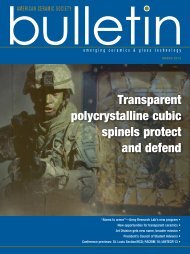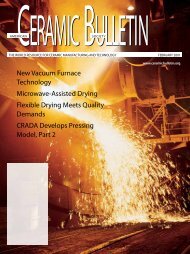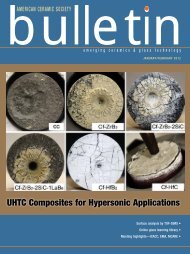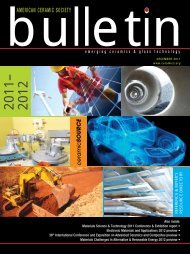American Ceramic Society Bulletin
American Ceramic Society Bulletin
American Ceramic Society Bulletin
Create successful ePaper yourself
Turn your PDF publications into a flip-book with our unique Google optimized e-Paper software.
esources<br />
Int’l Journal of Applied <strong>Ceramic</strong> Technology preview<br />
All ACerS members are provided free online access<br />
to the International Journal of Applied <strong>Ceramic</strong><br />
Technology. Go to www.ceramics.org, enter<br />
your username and pasword and then go to the<br />
“Publications & Resources” menu. Print subscriptions<br />
to this journal (not free to members) are sold online by<br />
Wiley–Blackwell Publishing, www.wiley.com.<br />
New papers are posted to the “Online Early” page as<br />
soon as they are ready for publication, even before the<br />
issue is printed. Below are samples of what’s coming.<br />
SiAlON–SiC Sandwich Structures with Tailored<br />
Surface Compression<br />
Kyle Hoff, David J. Green, Youngho Jin, Earle Ryba and<br />
John R. Hellmann<br />
This Pennsylvania State University research team evaluated<br />
the feasibility of producing high-hardness ceramic<br />
sandwich structures – SiAlON faces and SiC cores – with<br />
compressive residual stresses in the faces. The team reports<br />
that it was necessary to hybridize the SiAlON faces by<br />
adding SiC particles to reduce the thermal expansion mismatch<br />
between the face and the core and to avoid cracking<br />
during processing.<br />
Nanostructured, Infrared-Transparent<br />
Magnesium-Aluminate Spinel with Superior<br />
Mechanical Properties<br />
Thomas Mroz, Lee M. Goldman, Andrew D. Gledhill,<br />
Dongsheng Li and Nitin P. Padture<br />
These researchers from Surmet Corp. and Ohio State<br />
University fabricated nanostructured magnesium aluminate<br />
spinel with a highly uniform grain-size distribution for infrared<br />
window/dome applications using Y 2 O 3 sintering additive.<br />
They report that this spinel has high room-temperature<br />
strength, reliability, improved erosion and thermal-shock<br />
resistance, and near-theoretical in-line infrared transmission.<br />
Physicochemical Properties and<br />
Biocompatibility of Tricalcium and Dicalcium<br />
Silicate Composite Cements after Hydration<br />
Maryam Mazrooei Sebdani and Mohammad Hossein Fathi<br />
This research team from People’s Republic of China<br />
explored various proportions of Ca 3 SiO 5 and Ca 2 SiO 4 composite<br />
cements and evaluated their physicochemical properties<br />
and in-vitro biocompatibility after hydration. The<br />
team reports that the composites exhibited better strength<br />
and shorter setting time than pure Ca 3 SiO 5 or Ca 2 SiO 4 and<br />
that composite hydration products could induce formation<br />
of apatite layers on surfaces in simulated body fluid.<br />
Development of a Test Technique to Determine<br />
the Thermal Diffusivity of Large Refractory<br />
<strong>Ceramic</strong> Test Specimens<br />
James G. Hemrick, Ralph B. Dinwiddie, Erick R. Loveland and<br />
Andre Prigmore<br />
This Oak Ridge National Laboratory team has developed<br />
and validated a technique to use a high-intensity<br />
plasma arc lamp to measure thermal diffusivity of bulk<br />
refractory materials at elevated temperatures. They report<br />
that the new technique resolves sample size and inherent<br />
problems of current standardized test methods.<br />
Hexagonal-Boron Nitride as a New Ultraviolet<br />
Luminescent Material and Its Application<br />
Kenji Watanabe and Takashi Taniguchi<br />
Watanabe and Taniguchi report that high-purity h-BN<br />
crystals grown by the solvent growth method exhibit electronic<br />
excitation states near the band gap that are governed<br />
by optically allowed exciton effects. The excitonic<br />
luminescence bands can be used for far-ultraviolet plane<br />
light-emitting devices excited by field emitters.<br />
Depression Effects of Al on Oxidation of<br />
Diamond During Sintering of Diamond/<br />
Borosilicate Glass Composites<br />
Xianghong Zhang, Yanhui Wang, Jianbing Zang,<br />
Xiaozhe Cheng, Xipeng Xu and Jing Lu<br />
This research team from People’s Republic of China<br />
used aluminum powder as an oxygen getter to inhibit the<br />
oxidization and improve the wettability of diamond grits<br />
by the matrix during sintering of diamond/glass composites.<br />
The team reports the aluminum powder decreases volume<br />
expansion rate and increases bending strength.<br />
Fabrication and Characterization of Anode-<br />
Supported BaIn 0.3 Ti 0.7 O 2.85 Thin Electrolyte for<br />
Solid Oxide Fuel Cell<br />
Mathilde Rieu, Pankaj Kumar Patro, Thibaud Delahaye and<br />
Etienne Bouyer<br />
This international research team fabricated SOFC<br />
anode-supported half cells using a NiO–8YSZ anode support<br />
and a BaIn 0.3 Ti 0.7 O 2.85 electrolyte thin film. The team<br />
reports that the cermet electrode had a homogeneous<br />
microstructure with a well-defined anode/electrolyte interface,<br />
was stable at high temperature and retained dimensional<br />
control with no surface defects.<br />
50 <strong>American</strong> <strong>Ceramic</strong> <strong>Society</strong> <strong>Bulletin</strong>, Vol. 90, No. 4






